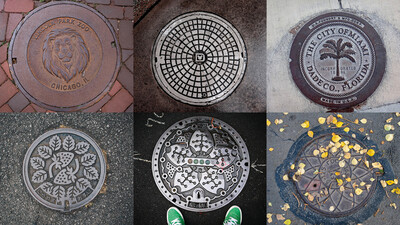Is an access cover the same as a manhole cover?
While access covers and manhole covers may look similar and serve a similar purpose, an access cover is used to provide access to smaller utility equipment such as water meters, stopcocks and hydrants. An access cover is generally small and made of aluminium, steel or composite material.
In contrast, a manhole cover will always be large enough to accommodate an adult body (a manhole’s full name is a ‘man-sized hole’) and is mostly used to access inspection and maintenance chambers for drainage systems and utilities. Most manhole covers are made of cast iron, steel or PVC.
Should I use a cast iron, steel or plastic manhole cover?
Cast iron manhole covers are the strongest of the three and are capable of withstanding loads of up to 90 tonnes. For this reason, cast iron manhole covers are widely used on public roads and highways, car parks and commercial or industrial areas where heavy vehicles and loads are to be expected.
Galvanised and stainless steel manhole covers are a sturdy, lightweight alternative to cast iron, but as they are only able to withstand weights of up to 17 tonnes, they aren’t suitable for locations where high-volume traffic or heavy loads are expected. Steel manhole covers can also feature a recessed top, which can be flush-filled with brick or concrete paviors, asphalt, resin-bound aggregate, or even grass. This makes them an ideal choice for domestic drives and gardens.
Plastic manhole covers are made of PVC or polypropylene, which makes them highly resistant to corrosion and chemicals. They don’t have a very high load rating, however, so their use should be limited to gardens and paths.
How can I disguise or conceal a manhole cover?
Manhole covers aren’t always placed in an ideal spot on a property and can look a bit of an eyesore in the middle of an otherwise unspoilt driveway or path, lawn or flower bed.
If you want to disguise a manhole cover in a driveway or path, you can choose one with a recessed top that can be filled with the same blocks or aggregate used for the drive or path. the narrow lip around the recess and the edge of the manhole frame will still be visible, but far less obtrusively than a full manhole cover.
A recessed lid can also be used to partly conceal a manhole cover in a lawn, although care should be taken to ensure the rim of the recess and the frame edge sit below the level of the turf to prevent damage to mower blades. Another way of hiding a lawn manhole cover is to turf it over entirely. This will only work if the manhole cover is low enough to allow a reasonable depth of soil above it for grass to grow, and you will need to be prepared for your lawn to be disturbed if access to the manhole is required. Whichever of the two options you choose, bear in mind that the root depth will be significantly less than that of the surrounding turf and the grass is more likely to suffer in warmer, drier seasons.
If you have a manhole in a flower bed or border, you may find a black plastic cover is sufficient to let it blend in with the surrounding soil or mulch, particularly if you can conceal it under the branches of a shrub or bush. For more effective concealment, a recessed cover can be filled with soil and covered with loose mulch that can be easily brushed to one side if access is required.
Can I build over a manhole cover?
If you are considering extending your property, there may be a manhole somewhere within the space you have allocated for the extension.
Building directly over a public sewer manhole is not only prohibited but undesirable, as odours from the sewer will be detectable inside the property. If you are building within three metres of a public sewer, you will also need to obtain a build-over agreement from your local water authority. To protect all sewers from damage, foundations for an extension will need to be kept at a safe distance from the pipes and/or excavated to a lower level than the pipes.
If your sewer is privately owned (i.e. serves only your property) and it isn’t possible to redesign the extension to avoid it, local authorities may allow you to install a sealed chamber that will prevent odours from escaping. Bear in mind, however, that should the manhole need to be opened, you will be in for an unpleasant experience until it has been re-sealed!
Who is responsible for maintaining and repairing manhole covers?
The responsibility for maintaining and repairing damaged manhole covers depends on where the manhole is located.
If it is on your property and forms part of the system used exclusively by your property, then you or the property owner will be responsible.
If the manhole is situated on your property but is on a part of the system that you share with neighbouring properties, it will be the responsibility of your local water authority.
Manhole covers situated outside of your property – for example, on the pavement or the road – are also the responsibility of the local water authority.
We hope you have found this information helpful and interesting. If you have any further questions, you are always welcome to call the friendly team of drainage experts at Drainfast on 01420 555600 or email [email protected].
Also, look out for more articles in our ongoing series of blog posts, bringing you useful information, insights, guides and tips on all things drainage!

Written by
Mark Chambers
Marketing Manager
As Marketing Manager, Mark plays an active role in running strategic projects to increase our brand profile.

